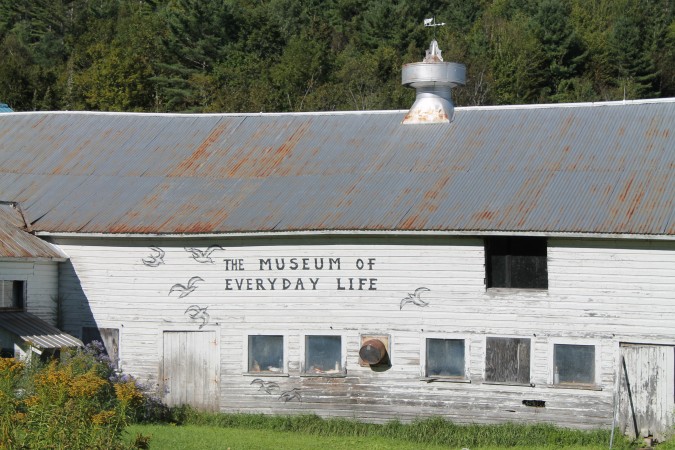The Museum of Everyday Life | Not Your Typical Museum
The Museum of Everyday Life is a self serve, honor system, roadside attraction, kinda like a farmstand, completely ensconced in an old cow barn along Route 16 in Glover, Vt. The Museum operates in much the same spirit the Bread and Puppet Museum, another cowbarn full of beautiful oddities five miles up the road, and […]

Matchstick Violin
Photo Credit : Julia Shipley
Photo Credit : Julia Shipley
The Museum of Everyday Life is a self serve, honor system, roadside attraction, kinda like a farmstand, completely ensconced in an old cow barn along Route 16 in Glover, Vt. The Museum operates in much the same spirit the Bread and Puppet Museum, another cowbarn full of beautiful oddities five miles up the road, and the predominant rule of both is: Turn the lights off when you leave.
Invented, arranged and maintained by Clare Dolan and friends, The Museum of Everyday Life, “shouts against the white walls of the traditional art and artifact institution: no more vitrines! Nothing under glass!” Hence, archivists, curators: take a deep breath. And teenagers being dragged around scenic New England by your so uncool parents: yank your earbuds and check it out: this is different.

Photo Credit : Julia Shipley
“We promise exhibits created by massive numbers of ordinary people! We promise a museum in which all things may be touched!” reads the handout manifesto celebrating the “detritus of our struggle to exist and thrive.”
And they deliver: the three year old museum has hosted three exhibitions, each show devoted to an incomplete, completely biased consideration of the glory of one single ordinary item. Year One: the match stick. Year Two: the safety pin. And this year: the pencil.
Upon flicking said light switch on and entering the yawning space, one can view remainders of the previous exhibits (Behold—the safety pin curtain, the diaphanous dress of safety pins, and the playable violin made out of matchsticks, fashioned by an inmate with a hankering for music, darn few supplies and plenty of time.)

Photo Credit : Julia Shipley

Photo Credit : Julia Shipley

Photo Credit : Julia Shipley

Photo Credit : Julia Shipley
Beyond this foyer, one enters the wood and graphite splendor of this year’s exhibit which features the history of the pencil, a pencil launching station, a wearable pencil costume, some gory photos of shall we say, ‘puncture wounds’? (don’t worry, the images have shutters so as to “protect the young and impressionable”). I learned about Thoreau’s family business (pencils) and fortuitous graphite deposits in Cumberland, England, and the Dixon company’s lucky gig making billions of #2s for standardized tests. But my eureka moment was the explanation of carpenter’s pencils. Always too shy to ask why they looked like they’d been flattened under an elephant, I discovered: so they don’t roll away from the working carpenter, and fit nicely behind the carpenter’s ear.

Photo Credit : Julia Shipley

Photo Credit : Julia Shipley
I also kindled some raw gratitude for this humble item, which, as graphite sculptor Dalton Ghetti puts it, “can write …without a battery or electricity…at extreme… temperatures…at zero gravity…and upsidedown…and underwater.”
I bumped into the Everyday mastermind (Clare) as she was doing her morning chores, and asked what she had up her sleeve for next year’s exhibit. She said, “I’m thinking about the toothbrush, but I’m open to suggestions.” My awareness newly heightened, I considered the penny I found later, outside the post office. I considered the postage stamp. I appreciated the Phillips- head screw still in my jean’s pocket following a chicken coop mend.

Then I studied our new kitten as she batted around a tiny piece of wire, turning this banal piece of trash into a saga of elusiveness and capture! Denial and attainment! Drama and intrigue and double cross! All in a twist-tie?
Hence my nomination for next year’s Everyday exhibit: the twist- tie.
Julia Shipley
Contributing editor Julia Shipley’s stories celebrate New Englanders’ enduring connection to place. Her long-form lyric essay, “Adam’s Mark,” was selected as one of the Boston Globes Best New England Books of 2014.
More by Julia Shipley

